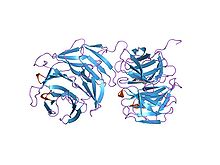- NHL repeat
-
NHL repeat 
Structure of the brain tumor-Pumilio translation repressor complex.[1] Identifiers Symbol NHL Pfam PF01436 Pfam clan CL0186 InterPro IPR001258 SCOP 1q7f Available protein structures: Pfam structures PDB RCSB PDB; PDBe PDBsum structure summary The NHL repeat, named after NCL-1, HT2A and Lin-41, is an amino acid sequence found largely in a large number of eukaryotic and prokaryotic proteins. For example, the repeat is found in a variety of enzymes of the copper type II, ascorbate-dependent monooxygenase family which catalyse the C-terminus alpha-amidation of biological peptides.[2] In many it occurs in tandem arrays, for example in the RING finger beta-box, coiled-coil (RBCC) eukaryotic growth regulators.[3] The 'Brain Tumor' protein (Brat) is one such growth regulator that contains a 6-bladed NHL-repeat beta-propeller.[1][4]
The NHL repeats are also found in serine/threonine protein kinase (STPK) in diverse range of pathogenic bacteria. These STPK are transmembrane receptors with a intracellular N-terminal kinase domain and extracellular C-terminal sensor domain. In the STPK, PknD, from Mycobacterium tuberculosis, the sensor domain forms a rigid, six-bladed b-propeller composed of NHL repeats with a flexible tether to the transmembrane domain.
References
- ^ a b Edwards TA, Wilkinson BD, Wharton RP, Aggarwal AK (October 2003). "Model of the brain tumor-Pumilio translation repressor complex". Genes Dev. 17 (20): 2508–2513. doi:10.1101/gad.1119403. PMC 218144. PMID 14561773. http://www.pubmedcentral.nih.gov/articlerender.fcgi?tool=pmcentrez&artid=218144.
- ^ Kano S, Miyajima N, Fukuda S, Hatakeyama S (July 2008). "Tripartite motif protein 32 facilitates cell growth and migration via degradation of Abl-interactor 2". Cancer Res. 68 (14): 5572–5580. doi:10.1158/0008-5472.CAN-07-6231. PMID 18632609.
- ^ Slack FJ, Ruvkun G (December 1998). "A novel repeat domain that is often associated with RING finger and B-box motifs". Trends Biochem. Sci. 23 (12): 474–5. doi:10.1016/S0968-0004(98)01299-7. PMID 9868369.
- ^ Edwards TA, Pyle SE, Wharton RP, Aggarwal AK (April 2001). "Structure of Pumilio reveals similarity between RNA and peptide binding motifs". Cell 105 (2): 281–9. doi:10.1016/S0092-8674(01)00318-X. PMID 11336677.
This article includes text from the public domain Pfam and InterPro IPR001258
Categories:- Proteins
Wikimedia Foundation. 2010.
